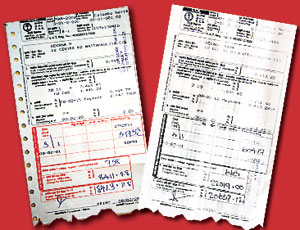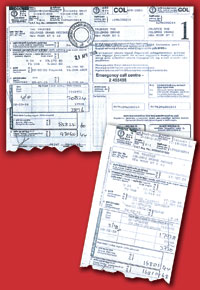
Consumers frizzled as electric shocks hit
Not only places of religious worship, and orphanages and elders homes, which are established for the sole purpose of serving the people but domestic users too, received an ‘electric shock’ when they received their electricity bills this month following the recent electricity tariff hike. The recently-revised electricity tariffs introduced a “Religious Purpose Tariff” which taxes places of religious worship, homes for the aged, orphanages and homes for the handicapped which are certified by the Director of Social Services as Charitable Institutions.
The ‘Maw Sevana’ in Colombo 15 has been operating as an orphanage for the past 30 years, caring for boys between the ages 8 and 16. Over the past months the electricity bill of the institution varied between Rs. 7,000 and Rs. 8,000. In the wake of the imposition of the electricity tariff hike, their bill jumped to a massive Rs. 22,019. The still shocked secretary to the board of management of the orphanage, Maurice Lord said what was most surprising was the fact that this massive tariff hike came despite the fact that the power consumed had been reduced from 715 units to 665 units. Mr. Lord said a large number of children from deprived sections of society are sheltered in orphanages which depend on donations. The skyrocketing cost of living has resulted in a decrease in donations and the new electricity tariff hike has made our plight worse, he said. Kingsley Thewarapperuma, Director of Victoria Elders Home, Rajagiriya, said there had been a huge increase in the electricity bill and they had no way to control the number of units used.“There are 180 inmates; most of them are bed-ridden, so lights and fans operate continuously. We also need water boilers and refrigerators,” he said. He pointed out that all charitable organizations would be facing additional burdens with the implementation of the new electricity tariff. The Chief Incumbent of the Sama Viharaya at Havelock Road, Ven. Dhammarakkitha Thera, said there had been a huge increase in the present electricity bill and it was similar to cutting welfare of the temple. “In religious places electricity is not wasted, it is used for religious purposes. In our temple fans and lights are used only in the Dhamma halls, social work and during religious observances. We have now decided to minimize religious observances after 8.30 p.m,” said the Thera. He added that this would turn out to be a major concern to temples in urban areas. Raja Warnapura, Secretary to the Dayaka Sabha of the Mallikarama Maha Viharaya in Ratmalana, said that there had been a significant increase in their electricity bill.
“Our electricity bill was usually less than Rs. 20,000, but this time it was a shocking Rs. 52,000. Placing burdens on religious places of worship which do not make any profit is not the best decision of the authorities” he said. The Chief Priest of the Sri Sivasubramaniam Swami Kovil, Saravana Sharma, said usually the electricity bill varied between Rs. 28,000 and Rs. 30,000. After the new tariff, the bill had risen to an astounding Rs. 161,000, he said. Nazushan Hassen, General Secretary of Colombo’s Grand Mosque, said the mosque had to accommodate around 5,000 worshippers every Friday in addition to worshippers who come to the mosque five times for daily prayers. The recent bill showed a 400% increase he said. “Usually the bill ranged from Rs. 13,409 to Rs. 20,351. During March the number of units consumed was 2,730 units and the bill was 16,801/44. During April the number of units consumed was 2,896 but the bill rose to a staggering Rs. 85,825. We use only lights and fans in the mosque during the five-time daily prayer” he said. The Ummu Zavaya Mosque in Colombo 12 which paid Rs. 9,066.24 for 901 units in March had to pay Rs. 29,577/92 for 721 units in April. The Parish Priest of St. Anthony’s Church Kochichikade said that previously electricity bills varied from Rs. 5,000 to Rs. 10,000 but last month the bill was Rs. 36,000. “This is a steep increase, the fans and lights in the church are used for the benefit of worshippers who come to the church throughout the day” he said. Secretary to the Parish Priest at St. Mary’s Church, Bambalapitiya said that the electricity bill for February was Rs. 7,376/- and the number of units consumed stood at 1,217 units. After the tariff hike the bill had increased to Rs. 11,992, though the number of units had decreased to 1,135. “This is indeed surprising and we strongly believe that the authorities should be more considerate toward places of religious worship and charitable organizations,” he said. |
|
||||||
|| Front
Page | News | Editorial | Columns | Sports | Plus | Financial
Times | International | Mirror | TV
Times | Funday
Times || |
| |
Reproduction of articles permitted when used without any alterations to contents and a link to the source page.
|
© Copyright
2008 | Wijeya
Newspapers Ltd.Colombo. Sri Lanka. All Rights Reserved. |

